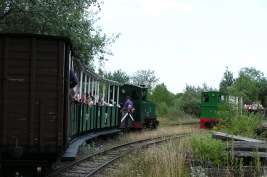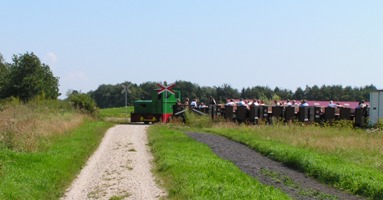|
Welcome to Hedelands Railway. |
|
|
|
|
The "Hedeland Vintage Railway" HVB is Denmark's longest
narrow gauge ( 700 mm) vintage railway. The HVB now offers a 10 km. return train ride in the
former large gravel pit, converted into a recreational area named Hedeland. The Railway is more than just a train ride through Hedeland's beautifull nature,
offering a whole new experience for some and a nostalgic memory of a past
century for others. We have both steam and diesel locos in
service.
Timetable. Sundays from may to september. Trains dept. from HEDEHUSGÅRD station, Brandhøjgårdsvej 2, 2640 Hedehusene, to Fem Ege station. 10:30 – 11:00 – 11:45 – 12:30
– 13:15 – 14:00 – 14:45 – 15:30
Please notice that we do not take any creditcards
About the railway. History, the line, news, research, books,
membership. Hedelands Veteranbane (the Hedeland
Vintage Railway) HVB is Denmarks longest narrow
gauge ( 700 mm) vintage railway, currently with a length of 5,3 km. Plans
exist for a further extension so that the railway in a matter of probably 10
years will be app. 7 km. long. Along the line. Books, newsletter etc. In 1998 the Danish Industrial Railway Society
published a book with descriptions of its locomotives and rolling stock.
Titled "Hedelands Veteranbane
- Materielfortegnelse" the 80-page book
contains photo and precise information on every locomotive in the club's
possession. The book is available through payment of 85,-
DKK incl. p&p, to the society's giro account 5 25 68 52, or use our bank connection: Danske Bank Køgevej 87, 2630 Taastrup. Regnr: 3129 account: 3129847603 . Also back issues of the society's newsletter is
available through payment to the giro account, a
full volume costing 50,- DKK. The society's
newsletter, 'Tipvognen' (the skip) is issued on a
regularly basis five times a year. It contains news from HVB, articles on
existing industrial railways in Denmark and neighbouring
countries besides historical articles. Research. The Danish Industrial Railway Society has through
the years collected a large amount of information on industrial railways in
Denmark. Both documents, pictures, drawings and also memories of former
employees has been assembled in the archive The research has led to countless
new discoveries and is increasingly taking place in co-operation with
enthusiast abroad. Do You have any questions on Danish industrial railways
You can contact the leader of the society's archive or leader of research. Leader of archive: Peter Andersen Leader of research: Bent Hansen Longer railway 5.3 km. New distance of main line We've finished the last 150 metres of track during the Vinter 2006-2007 and the
13. february 2007, the
line was connected to the tracks on the bridge. At 14.20 pm. the first train,
with dieselengine M12 in front, crossed the bridge,
leaving Høje Taastrup,
entering Greve. The bridge over the major road
between Roskilde and Greve was biuild
in 1987, and it's been vaiting for traintraffic for almost 20 years. The last tamping and
ballast works need to be done, before we're continuing on the other side. I'ts the plan that we during spring do aprox 60 metres before an
official celebration are made. After that we have to
wait until the major works preparing the trackbed
towards Tune are ready for tracklaying. A few years ago the earth works for the 1,5
km extension was completed, and after a year of hard work we have succeeded
in getting the tracks down. The new station at the end of line, 5 km from our
main station - Hedehusgaard are finished and all
trains terminates here. The new extension is built with our standard rail
profile (24 kg/m) on used wooden sleepers. Steam locos: HVB have for a long time been busy restoring a
O&K-engine (O&K 7459/1921) and that work will be continued through
2007. The work was planned to terminate in late summer 2002 - resulting in a
restored example of what was a very common type of steam loco on the danish marl railways during the twenties and thirties,
but other upcomming projects has been taking our
time. Our only workable steam engine, Da 7 (Henschel
18449/1921), expirenced a crack in the boiler
during the 2000-season. The crack was welded and Da 7 continued working the
passenger trains, but it was decided not to use the loco in the 2001-season
on safety reasons. A new boiler for Da 7 was ordered in early 2002 and Da7 is
now in ordinary service again. The boiler costs about 315.000 danish
kroner (42.000 €), seemingly not a fortune, but nevertheless a substantial
amount for a small club like our's. Diesel locos: During 2003/04 we have restored a four cylindred
diesel engine, build at the sugar factory in Nakskov
1962. The loco vas in service until 1968. IBK bought it in 1974. Link
to some pictures of M24. Still going strong... Traffic on HVB has been satisfactory the last few years with a steady
increase in revenue. This has been mostly due to carefull
planning of the specially chartered trains (usually on week days). We have
tried to balance the price of the trains with the manpower available for
running the trains and have through this method gained the benefit of high
earnings with the least use of our members'
limited spare time. "Once upon a time..." 25 years ago HVB was officially opened, and allthough
the railway was only 100 m long, it nevertheless represented a dream come
true for the pioneers of the Industrial Railway Society. Over the next
quarter of a century these 100 m have grown into a
almost 5,2 km long railway with workshops and sheds,
steam locos and 10.000 passengers a year. More than 50 locos have been aquired and over the years the volunteers learned how to
run a railway - even profitable! Several arrangements through the year will
serve to commemorate the aniversary for the general
public as well as our members. Membership. Membership of the society can be obtained by the payment to the club's account: Danske Bank Køgevej 87, 2630 Taastrup. Regnr: 3129 account: 3129847603. The club's general address is: IBK / HVB
|
|

